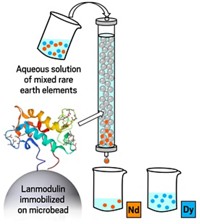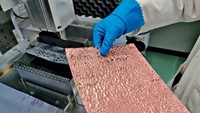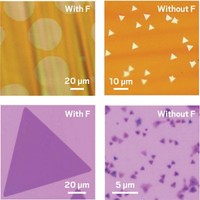Advertisement
Grab your lab coat. Let's get started
Welcome!
Welcome!
Create an account below to get 6 C&EN articles per month, receive newsletters and more - all free.
It seems this is your first time logging in online. Please enter the following information to continue.
As an ACS member you automatically get access to this site. All we need is few more details to create your reading experience.
Not you? Sign in with a different account.
Not you? Sign in with a different account.
ERROR 1
ERROR 1
ERROR 2
ERROR 2
ERROR 2
ERROR 2
ERROR 2
Password and Confirm password must match.
If you have an ACS member number, please enter it here so we can link this account to your membership. (optional)
ERROR 2
ACS values your privacy. By submitting your information, you are gaining access to C&EN and subscribing to our weekly newsletter. We use the information you provide to make your reading experience better, and we will never sell your data to third party members.
Sustainability
Eco-friendly technique selectively recovers copper from circuit board waste
Ball-milling technique pounds the copper out of trashed circuit boards
by Louisa Dalton, special to C&EN
February 15, 2019

Tossed circuit boards are about 20% copper, a much larger fraction than the roughly half a percent in copper ore mined from the ground. That percentage, plus the growing mounds of global electronic waste, drives the hunt for effective and green methods for extracting copper from circuit boards.
A new method takes advantage of ball milling, a brute force means of jumpstarting chemical reactions (Environ. Sci. Technol., 2019, DOI:10.1021/acs.est.8b06081). If the simple process can be scaled up, it would be more eco-friendly and efficient than current methods for recovering copper from circuit boards.
Global electronic waste exceeds 40 million tons and is growing at a rate of 3-5% per year. Circuits boards make up 2 million tons of that total. China, one of the largest producers of circuit boards and the major recipient of global electronic waste before the country limited the import of many types of waste in 2018, is struggling under the environmental consequences of this waste. “Improper handling of waste circuit boards has generated serious environmental problems and human health threats in China,” says Huijie Hou, an environmental engineer at Huazhong University of Science and Technology (HUST).
Conventional recycling methods have serious drawbacks. Pyrometallurgy, which separates metals by incinerating them at high temperatures, emits toxic gas products and is hard to control. Hydrometallurgy, which uses strong acid to leach the metals, results in large volumes of acid wastewater. Both require significant technical know-how and careful handling of the toxic byproducts.
An industrial waste treatment company in China, Dongjiang Environmental Protection Company, asked Hou, her colleague at HUST Jiakuan Yang, who specializes in solid waste treatment, and coworkers, to research and develop a high-efficiency copper recovery method for waste circuit boards. They hoped to generate a mechanical or physical separation method that would limit the chemical waste, Hou says.
The scientists turned to ball milling, an old technique for recovering metal from ores. The strong collisions of zirconia grinding balls hitting the wall of a zirconia ball-milling pot generate spikes of high energy, sparking solid-phase chemical reactions at room temperature. Copper metal generally wouldn’t be considered a good candidate for ball milling reactions because it is too stable, Hou says. But Hou and coworkers added a key oxidizing solid to the mix as well: potassium persulfate.
After crushing waste circuit boards to a coarse powder, the scientists milled the particles with solid potassium persulfate for 4 hours. Copper metal reacts directly with potassium persulfate in the high energy collisions of the ball mill to form cupric sulfate and copper oxide. Then they added the powder to water. In water, the copper compounds dissolve and the copper oxide reacts with potassium bisulfate, a breakdown product of the potassium persulfate, to form cupric sulfate. The powder containing the remaining solids from the circuit board—mostly brominated epoxy resin and glass fiber--is left behind. The researchers found they could transfer 99.8% of the copper from the waste circuit boards to the water with this approach. A final recrystallization step yielded purified cupric sulfate.
Advertisement
Small amounts of other circuit board metals, such as lead and tin, are also in the powder and can be further purified. They oxidize in the ball mill but don’t dissolve in water, making the process highly selective for copper.
Carbon monoxide and sulfur dioxide gases are produced in the process. These gases and the liquid byproduct, potassium sulfate in water, are easier to manage than the gas dioxin emissions from pyrometallurgy or the strong acids from hydrometallurgy, Hou says.
Waste printed circuit boards are the most difficult-to-handle components in e-waste, says Xianlai Zeng, an expert in urban mining and electronic waste at Tsinghua University who was not involved in the study. This laboratory route for copper recovery is innovative and more efficient than current methods, he says, but bringing this new process up to an industrial level will take a lot more work.
Hou isn’t sure if this technique will work on an industrial scale; the ball milling machine may require too much energy. But they have patented the process and her group is working with Dongjiang on a possible scale-up of the method.





Join the conversation
Contact the reporter
Submit a Letter to the Editor for publication
Engage with us on Twitter